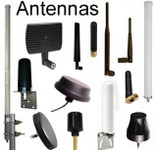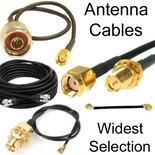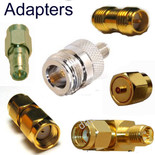Antennas, Antenna Cables, Wireless Products: Technical Articles
Evolution of Antenna Design in 5G Networks | Massive MIMO
Antenna Technology Advancements for Next-Gen Cellular Connectivity
As 5G networks continue to roll out globally, antenna technology has undergone significant advancements to meet the demands of this next-generation connectivity. With promises of ultra-high speeds, low latency, and massive device connectivity, 5G has set a high bar for performance, requiring antenna designs that are innovative and adaptable to complex challenges. Key areas of evolution include Massive MIMO (Multiple Input, Multiple Output), millimeter-wave (mmWave) frequencies, and overcoming integration challenges in diverse deployment scenarios.
The Role of Antennas in 5G Performance

Antenna systems are the backbone of wireless communication, directly influencing network capacity, coverage, and reliability. In 5G networks, they must support:
Higher data rates through wider bandwidths.
Lower latency for real-time applications.
Massive device density, especially in IoT-heavy environments.
These requirements necessitate fundamental changes in antenna design beyond the capabilities of traditional 4G LTE systems.
Massive MIMO: The Game-Changer

Massive MIMO technology is a cornerstone of 5G networks, enabling base stations to handle multiple data streams simultaneously. Here's how it’s reshaping antenna design:
Increased Array Complexity:
Traditional MIMO systems use 2 to 4 antennas; Massive MIMO systems in 5G employ dozens or even hundreds of antenna elements.
These arrays improve spectral efficiency by directing signals through beamforming, reducing interference and increasing capacity.
Beamforming and Beam Steering:
Beamforming focuses signals toward specific users or devices, enhancing signal strength and reliability.
Adaptive beam steering allows antennas to dynamically track mobile devices, maintaining strong connections even in challenging environments.
Compact Designs:
Despite the increase in elements, antennas must remain compact for practical deployment. Advanced materials and innovative layouts are used to integrate many antennas into small enclosures, such as those on streetlights or building facades.
Millimeter-Wave Frequencies: Breaking New Ground
The introduction of mmWave frequencies (above 24 GHz) is one of the most significant shifts in 5G technology. These bands offer massive bandwidth but come with unique challenges that impact antenna design:
Shorter Wavelengths:
Millimeter waves have shorter wavelengths, enabling smaller antenna elements, which is ideal for dense arrays in massive MIMO systems.
Propagation Challenges:
mmWave signals face higher attenuation and difficulty penetrating obstacles like walls and trees. This necessitates highly directional antennas and precise beamforming to overcome path losses.
Integration in Small Cells:
mmWave antennas are increasingly integrated into small cells to provide localized coverage. These cells require ultra-compact, efficient designs that can be deployed in urban environments.
Thermal Management:
mmWave antennas, especially in dense arrays, generate significant heat. Designing for effective heat dissipation is critical to maintaining performance and longevity.
Integration Challenges in Diverse Deployments
The deployment scenarios for 5G networks are more varied than ever, from dense urban areas to rural settings. Antenna design must adapt to these environments while maintaining performance and cost-efficiency:
Urban Environments:
Small Cell Integration: In cities, antennas are integrated into street furniture (e.g., lampposts, bus stops) to blend seamlessly with the environment.
Interference Mitigation: Dense deployments require precise design to avoid signal overlap and interference.
Rural Areas:
Rural deployments rely on fewer, larger base stations with high-gain antennas to maximize coverage.
Antennas must handle lower frequencies (e.g., sub-1 GHz) for broader propagation.
IoT and Private Networks:
Antennas for industrial IoT and private 5G networks are tailored for specific use cases, such as factory automation or smart agriculture, requiring custom designs for reliability and durability.
Form Factor and Aesthetic Considerations:
To reduce visual impact, antennas are designed to be less conspicuous. This often involves radome enclosures and integration with building designs.
Future Trends in 5G Antenna Design
As 5G continues to evolve and pave the way for 6G, antenna technology will need to keep pace. Emerging trends include:
Reconfigurable Intelligent Surfaces (RIS):
Surfaces embedded with antenna arrays can dynamically control signal reflection and refraction, improving coverage and reducing dead zones.
Advanced Materials:
Use of materials like graphene and metamaterials to enhance antenna performance, reduce size, and improve energy efficiency.
Integrated Antenna Systems:
Integration of antennas directly into devices, vehicles, and even clothing for seamless connectivity.
Energy Efficiency:
Designing antennas that minimize power consumption is becoming a priority, especially for sustainable 5G deployments.
Conclusion
The evolution of antenna design is critical to realizing the full potential of 5G networks. Technologies like Massive MIMO, mmWave, and innovative integration solutions are pushing the boundaries of what antennas can achieve. As deployment scenarios become more diverse and performance demands increase, antenna innovation will remain at the forefront of 5G’s success.
At Data Alliance, we provide cutting-edge antenna solutions tailored to meet the unique challenges of 5G networks. Contact us to learn more about how our antennas can enhance your 5G deployments.







